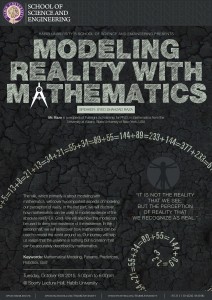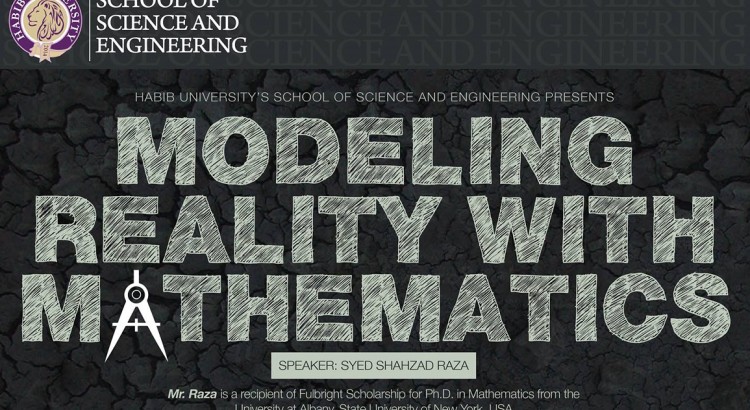Syed Shahzad Raza is currently a lecturer of Mathematics at Habib University. Mr. Raza gave a talk which covered important aspects of modeling our perception of reality. In the talk, Mr. Raza explained how basic mathematics can be used to model and solve problems in natural and social sciences. A brief lecture video of Mr. Raza’s talk is also available on Habib University official Vimeo channel.
https://vimeo.com/143588404
By Syed Shahzad Raza
“It is not the reality that we see, but the perception of reality that we recognize as real.”
Mathematics, along with its abstract nature, has enormous applications in social and natural sciences. Be it the area of artificial intelligence, biology, economics, chemistry, engineering or physics; the queen of all sciences, i.e. mathematics, dominates these domains with glory and pride. Knowing such significance of mathematics in all areas of sciences, it becomes imperative for every researcher to explore this kingdom for answers to her/his problems. This leads to modeling of reality; with mathematics providing the right tools, techniques and solutions.
 Variables and their relationships play a key role in defining a mathematical model. Such models can be either linear, non-linear, discrete, continuous, deductive and/or inductive, etc. The talk, Modeling Reality with Mathematics, focused on some elementary examples to show how real-world observations can be modeled using basic tools from mathematics. It questioned how system parameters of interest can be used to make predictions in social sciences and how other variables can be used to maneuver a robotic arm. In order to answer these questions, the talk started and concluded with the fact that mathematics relies on observations to model uncertainty. It was conveyed that these observations, once translated into mathematical equations, allow us to make predictions or to analyze behaviors of the real-world systems under consideration.
Variables and their relationships play a key role in defining a mathematical model. Such models can be either linear, non-linear, discrete, continuous, deductive and/or inductive, etc. The talk, Modeling Reality with Mathematics, focused on some elementary examples to show how real-world observations can be modeled using basic tools from mathematics. It questioned how system parameters of interest can be used to make predictions in social sciences and how other variables can be used to maneuver a robotic arm. In order to answer these questions, the talk started and concluded with the fact that mathematics relies on observations to model uncertainty. It was conveyed that these observations, once translated into mathematical equations, allow us to make predictions or to analyze behaviors of the real-world systems under consideration.
References
Freedman D. A., 2009: Statistical Models: Theory and Practice.
Cambridge University Press.
Holdener J., 2007: Modeling Population Growth with Sequences [Available online at
http://personal.kenyon.edu/holdenerj/Math108Spring2007/classnotes/sequences/lesson2sequences.htm.]
Hosmer, D. and Lemeshow, S., 2000: Applied Logistic Regression.
John Wiley & Sons, Inc.
Kayahara N., 2003: Silhouette Illusion [Available online at
http://www.procreo.jp/labo/labo13.html.]
KeysToMaths1, 2013: Q8 Trigonometry – Robotic Arm [Available online at
https://www.youtube.com/watch?v=d76EKLRnuKM.]
Kharkar R., 2015: The Mathematics of Robotics [Available online at
https://www.youtube.com/watch?v=YoSrnUh7Q-E.]
R Online Manual
Rickard S., 2011: The world’s ugliest music [Available online at
http://tedxtalks.ted.com/video/TEDxMIAMI-Scott-Rickard-The-Wor.]

